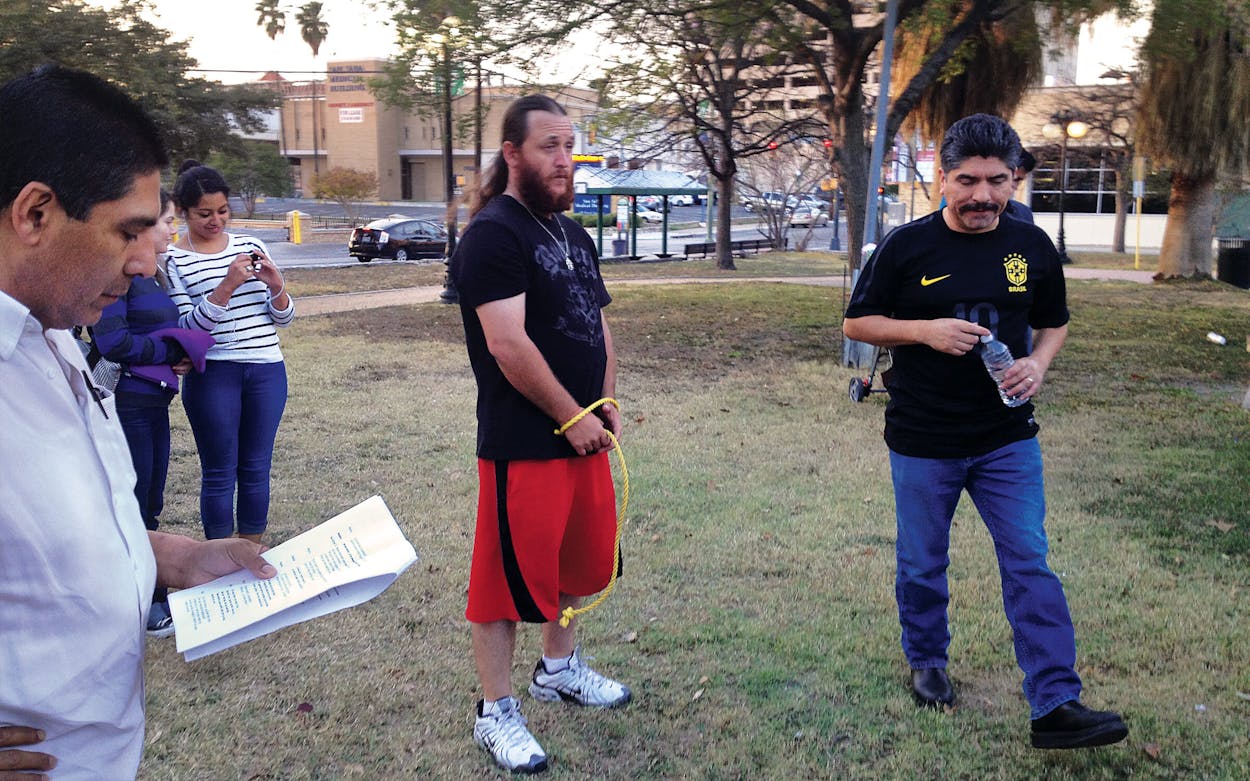Mario Mandujano had finally chosen his Jesus. “I was looking for the long hair, tall, with a beard,” the 46-year-old volunteer director of San Fernando Cathedral’s Passion Play said last March. But Mandujano also sought dedication. For months he’d been working with two unpaid contenders. Finally, with ten days to go until Good Friday, Mandujano selected his savior, Elmendorf city worker John Austin.
Now it was time for the last rehearsal. After fifty or so had gathered in the Elizondo Plaza, next to the San Antonio cathedral, Mandujano led them to Milam Park, a few blocks south, to rehearse the trial scene. Austin, a densely built man in his thirties with a bushy red beard and long brown hair, positioned himself across from a row of “guards.” A cluster of actors formed the “hostile crowd.” Mandujano moved through them quickly. “Three Marys,” he said, pointing toward three women locking arms, “you don’t want Jesus crucified. Everyone else, be mean.” A few of the veteran players repeated “mean,” furrowing their brows.
Some of the actors knew the script well, having participated for years, and they operated as informal assistant directors. Others desperately needed the practice. The Shield of Christ Motorcycle Ministry members who played Herod’s soldiers, for example, had difficulty standing in formation. When Mandujano instructed them to turn to the right, they turned every which way. Mandujano winced. “Your other right,” he said.
Mandujano joined the 1,500-person parish in 1984, at the beginning of December, after moving from Guanajuato, Mexico. The priest was searching for a Joseph for the Christmas Posada procession and thought Mandujano looked the part. “He told me, ‘I have a Mary. Come by Tuesday and meet her.’ ” Mandujano met her, performed Joseph alongside her at Christmas, and, two years later, married her in real life.
When Mandujano first took over the church’s three productions—the Passion Play, La Gran Posada, and La Serenata to Our Lady of Guadalupe—the Passion Play involved 45 people (including the mob that goads Herod into action). These days, that outdoor performance has grown to include 90 actors, with an audience of 22,000 craning their necks to watch. The popularity is due, in part, to Mandujano’s commitment. In 1992, after stints as Joseph, Herod, Pontius Pilate, and a guard, he volunteered to oversee the performances, from costume design to audience outreach. (He has never played Jesus. “Too short,” his wife, Lupita, explained.) While Mandujano spends half his year planning shows, “director” isn’t his full-time job. During the day, Mandujano is a food-service manager for the San Antonio Independent School District, and in the late afternoon he caters supper for a group of Catholic nuns. Those jobs pay the bills, but the theatrical productions are his calling. “I think I was an actor in another life,” Mandujano said.
The group began its second run-through around dusk, growing more comfortable in their roles, and the spectators—mostly dog walkers and women pushing baby carriages—faded into the darkness, emboldening the participants to shout more passionately, “¡Ese hombre falso! ¡Falso!”
On the procession back from Milam Park to the cathedral, where the crucifixion scene would take place, Austin walked in the center of the group, holding his preschooler’s hand. “They’re not gonna hit you anymore?” his son asked flatly, as if confirming the script. Austin shook his head. When asked how he felt about his part, he took a somber moment to think. “Jesus is a heavy role,” he said. “You see things from a different perspective.”
Near the front of the crowd, a woman named Catolina Avila said she has performed in the Passion for twenty years under Mandujano’s direction. “I’ve been Maria, Veronica, Magdalena,” she said. “I missed last year because I had surgery in one knee.”
“Mother of Jesus is the hardest,” said Linda Daniel, who wore a red T-shirt that read “Passion Play 2010” and had also played many roles in her thirteen years of participation. “During practice, we joke around, but when it comes to the day,” she said, “people cry.”
After the group arrived at the cathedral, Mandujano reminded the guards how to put Jesus on the cross before giving his parting instructions. “Pueblo, ándale. This year I want everyone close to the stage, and when they bring Jesus down, follow. That’s a little different from last year. And when you come, no fingernail polish. Shhh! Listen. No jewelry, no phones, no glasses.”
“He wants it to be as authentic as it can be,” a woman nearby whispered.
“And no cameras!” Mandujano said, pleadingly. “Por favor.”
- More About:
- Theater
- San Antonio









